“I’m told I’m famous on the internet”
Henri the Cat and the Critical Possibility of Anthropomorphism
DOI: https://doi.org/10.52537/humanimalia.9910
Caitlin Rose Myers is a PhD candidate at The University of Arizona in Tucson. She specializes in British Romanticism, the Gothic, the medieval legacy of romance, and posthuman theory.
Email: crrodrig@email.arizona.edu
Humanimalia 6.2 (Spring 2015)
Abstract
This paper examines the phenomenon of feline Youtube celebrity in the context of human/nonhuman animal interactions and the construction of the posthuman subject. I argue that “Henri,” or Henry, the Youtube star, presents the particularized difficulties of both human and nonhuman animals, including Derridean “nonpower,” manipulation through medium (virtual or otherwise), and the performativity of identity. While Derrida explicitly derides anthropomorphism as “a moralizing subjection, a domestication” in his The Animal That Therefore I Am,I will further argue for the critical possibilities of anthropomorphism using popular responses to the Henri videos alongside recent theoretical perspectives that argue for its necessity. This multimedia presentation aims to demonstrate that it is possible to draw the public fascination with feline celebrities into conversation with questions of what it means to be “human” or “animal,” as well as what it means to present oneself as “being” in a posthuman world.
The cultural phenomenon of the humorous Youtube cat video often seems indissoluble. While most examples are from one- or two-hit wonders (thank you, roomba-cat-swats-dog and kitten-vs-a-scary-thing), there are the few that become significant enough that they inspire widespread followings. I am thinking specifically of feline celebrities such as Maru the box-lover, Happy Cat the originator of the LOL-cat sensation, Lil’ Bub, and Grumpy Cat. These sorts of cats are hyper-individualized to the point of stardom and can thus be examined as indicative of popular culture’s perception of the division between “human” and “animal.” These interactions further take place in a postnatural, virtual space, and are mediated through technological and verbal lenses that they explicitly and implicitly critique. I will specifically examine Henri the Existential Cat and his first video in the context of individualization and Derridean “nonpower,” as well as the way in which feline celebrity reveals the critical possibilities of anthropomorphism.
Jacques Derrida’s The Animal That Therefore I Am, a translation of the ten-hour long address to the 1997 “Autobiographical Animal” Conference, posits that the process of individualization is imperative when considering the nonhuman animal and its gaze. He speaks specifically about the experience of being stared at by a cat while naked, but clarifies quickly, “the cat I am talking about is a real cat, truly, believe me, a little cat. It isn’t the figure of a cat. It doesn’t silently enter the bedroom as an allegory for all the cats on the earth” (6). This cat is not aggregate and resists instinctive human attempts to pluralize it — Derrida says that he clarifies in order to “mark its unsubstitutable singularity” (9). As long as trauma is not involved, it is often assumed that one cat’s mental framework must be roughly equivalent to that of another’s. Yet “Henri” is set apartthrough the “director” Will Braden’s efforts to reinforce his individuality. Some part of this arises from the public availability of his name. The first “Henri” video begins and ends with his name — from “My name is Henri” to “I am Henri” — and this repetition indicates the deliberate association the filmmaker wishes to make between the statements made during the video and the individual, named entity. The importance of Henri being alone, set apart from humans and other cats, is that it allows him to be identified by the viewer as a conscious, unique subjectivity.
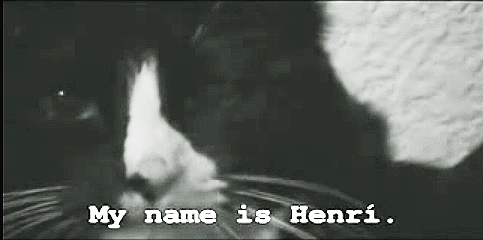
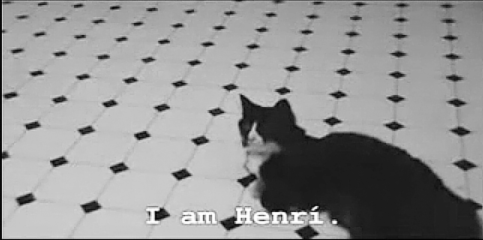
Figures 1 & 2: Opening and closing shots of “Henri”
This transition from “my name is” to “I am” is one of the many intersections between these videos and Derrida’s lecture. The ironic humor in the Henri videos is undeniable, but at the core of this irony is a perceptive analysis of subjectivity’s presentation and representation. Just before the second repetition of his name, Henri watches a dark shadow above him as Braden’s voice speaks: “I am haunted.”
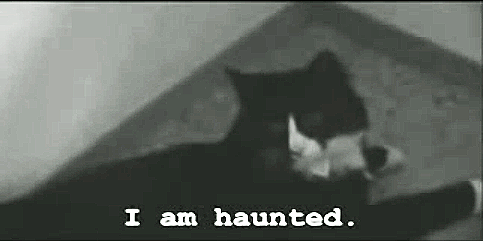
Figure 3: "Haunted"
Bracketed between the two utterances of his name, Henri experiences the ghostlike separation from the word/name that he is bound to. Derrida says that “every case of naming involves announcing a death to come in the surviving of a ghost, the longevity of a name” (20). The separation between the conscious individual and the construction of the name is like that between body and spirit; we are all “haunted” by the names that are only tenuously and temporarily attached to us. In this way, the same word that can give us the power of unique subjectivity contains within it the “nonpower” of our separation from language. In the opening shot of the first “Henri” video, the cat-speaker dominates the frame in an extreme close-up while verbally separating himself from the word given to him — it is only a “name” that Derrida says indicates how both human and nonhuman animals are “deprived of language” — as Derrida exclaims, “As if man didn’t also receive his name and his names!” (32). Henri is the emphasis in the video’s opening shot, but the text instead emphasizes that his “name” is Henri, and the disjunction between the two subjects is palpable. The video then ends with a shot in which Henri is off-center and smaller than the frame encompassing him, failing to embody his name even as he attempts to claim it. It is a melancholy shot that contradicts his seeming ownership of the word, especially in the context of Henri the “haunted.” His “I am” rings desperate and forced. Derrida calls the inability to connect tangible form to the ghostly spirit of language a “nonpower at the heart of power” (28). Nonhuman animals are considered to be typically without power because they do not have access to language. They do not speak as we do, cannot represent themselves through words, and are therefore separate from us — and by separate, we mean below. Henri exposes and dismantles this language barrier between human and nonhuman by showing that both experience the painful struggle to embody a name that is intrinsically separate from us. Henri suffers the impossibility of representation within the constraints of language as we do, even as he utilizes it in what is presented as an attempt at autobiography.
Autobiography is, in fact, at the center of Derrida’s critique of representation through language. He connects the autobiographical gesture of “present[ing]” oneself to the same ghostly sensation of naming and to the “first autobiographical gesture and the gesture of all the ‘Here-I-am’s’ in the history of the law” (85). The animal looks at him and he responds instinctively with an attempt to construct an identity, and the mirror (or the autobiographical text) captures this construction. This attempt is, however, a “spectral drama” and the autobiography is a “sepulcher,” housing only the empty ghost of language with none of the real body, human or nonhuman, present (75). The term “drama” calls attention to the performativity of this “Here-I-am,” and part of the humor of the Henri videos comes from being presented with the human tendency to over-perform ourselves.The phrase “I am” appears again and again in the first Henri film, and each instance is another re-presentation of a speaker that tries to construct a sense of self through language. Each gesture is also false, as all masks are false and therefore display the “nonpower” of self-deception contained within the power of presenting. “My caretakers love me” is a story that Henri must tell despite evidence of distaste, as the video overall is a story that slides over the truth uncomfortably and cannot settle.
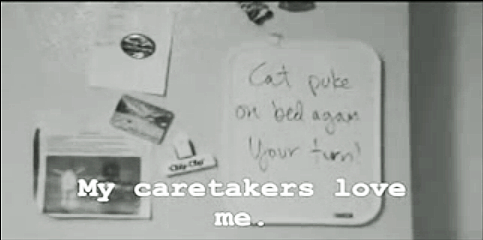
Figure 4: Autobiography
In popular articles about the Henri films, both Melissa Morrissette and Deborah Netburn refer to the relationship between the cat that Braden films and the cat that emerges as a result as that of actor and role. “Henri” is an “actor,” Morrissette writes, whose name is “actually Henry” — a transition from one assumed title to another that nevertheless calls attention to the arbitrary gift of language. Henry the cat is “a difficult star” who is coached into the presented narrative despite not fitting directly into the proffered mold (Netburn). This difficulty calls attention to the autobiography itself as a discomforting gesture. Just as the statements in these videos are explicitly a performance, all outward signs of inward emotional states can be seen as a performance as well. Caught in the mirror (or in the eyes of the Other), the self performs another self. In this case, the lens of the camera causes the “spectral drama” to extend its reach beyond a single video. Through the constantly expanding online network, this spectral and speculative notion of identity spreads out like a virus. What occurs through this lens is a performance for this expansive audience, just as all efforts to present the “I am” are responses to the discomfort of the gaze that asks for definition. Henri seems intended to raise awareness of this fact.
Yet all of this discussion of autobiography may seem to erase the distinction between the human and the nonhuman to an unfortunate end. If we think of Henri as an actor with a role, then we think of him as human and engaging in a human act. Derrida explicitly discusses the dangers of anthropomorphism: “We know the history of fabulization and how it remains an anthropomorphic taming, a moralizing subjection, a domestication. Always a discourse of man, on man, indeed on the animality of man, but for and in man” (37). This is a critique that must be dealt with in the context of the “Henri” videos. Henri’s difficulties are specifically human — his words are taken from human mouths and, when he empathizes, he seems to do so specifically to draw a human audience to consider human concerns.
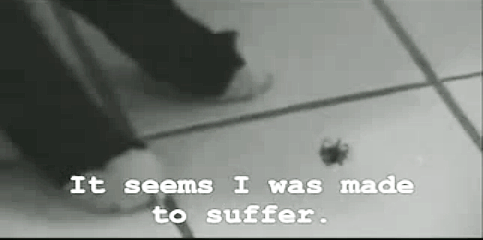
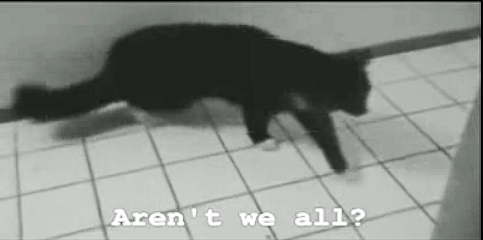
Figures 5 & 6: Anthropocentrism
Even when he uses these words in a feline context (to discuss chasing and killing a spider, for example), there is no serious consideration of this context in the video itself. Some responses to the “Henri” videos absorb this sort of anthropocentrism and ultimately reinforce language as the barrier between human and nonhuman. Although Derrida finds the animal interactions in the Alice in Wonderland books productive (the flamingo that turns to look Alice in the face, causing her to laugh, is of particular note in reference to Henri), he acknowledges that Alice’s statement about her cat’s inability to respond because it can’t speak is entirely missing the point (8). Such a statement avoids the deceptive nature of language in itself and demands that all creatures present themselves through it or be forever silenced. Henry’s owner makes an almost identical statement when she says that “there’s no way to convey to him how many people know of him,” as if a cat would care about stardom or a verbal discussion about it (Netburn). This is one end to which one can take anthropomorphism: the complete erasure of the animal by making that animal either another human or refusing it consciousness entirely. As Derrida notes, Alice learns her lesson, or at least we learn it as a result of her adventures. In a land where “this way” and “that way” lead to the same place (madness), language and consciousness are equally unreliable. Derrida says that “the said question of the said animal in its entirety comes down to knowing not whether the animal speaks but whether one can know what respond means” (8). The Cheshire Cat speaks and is therefore anthropomorphized, but it is through this anthropomorphism that we question language as a structure and ask ourselves what a “response” entails. We thereby uncover the tools for a critique of anthropomorphism even as we practice it.
Derrida questions his own derision of anthropomorphism when he asks if refusing to project could mean, “depriving the animal of every power of manifestation,” and especially of its power to criticize “its experience of my language” (18). This describes the first “Henri” video precisely. The film uses the performance of human consciousness to dismantle it and its belief in the representational powers of language. Derrida calls the gaze of the animal “bottomless”; like “the eyes of the other, the gaze called ‘animal’ offers to my sight the abyssal limit of the human” (12). Through this vast unknown, the animal gaze reflects back toward the human the gulf of what it can never encompass. The animal shows the human its limits through both a critique of its methods and the possibility it represents of an outside to language. Henri fits both of these criteria.

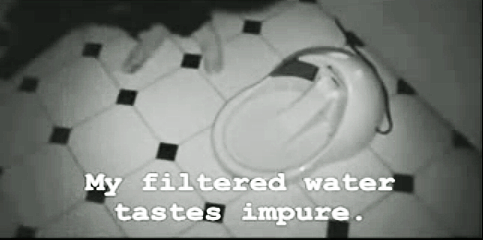

Figures 7, 8 & 9: Reflecting Back
First, his narrative includes a criticism of the human tendency to rely upon a “life of luxury” and the “filtered” though “impure” taste of the artificial, and we laugh as an audience because we recognize ourselves in this hollow materiality. We too are surrounded by machinery meant to make our lives comfortable and yet we feel alone.
Even more damning, Henri draws attention to the comedy of our excessive and self-inflicted sadness. Popular journalist Matthew Manarino makes this point when he compares Lovecraft’s “cosmic futility” to Henri’s: “’The world is indeed comic, but the joke is on mankind.’ Lovecraft’s melancholy has become a shared sentiment among not only mankind but also those guardians of the Internet — existential cats.’” We sympathize as we laugh, and these simultaneous reactions are a result of Henri’s dismantling of autobiography. We invite the artificial materiality that causes our melancholy and then blame our items for owning us. Similarly, our devotion to the sovereignty of language is of our own making and we suffer within its constraints. If this is what it means to be human, Henri implicitly states, then why aspire to it?
The true goal for the study of the animal is, as Derrida states, releasing it from human reinterpretation. The animal does not need or want to be “giv[en] speech back” — it is “the absence of the name and of the word” and it lacks nothing as a result of being separate from language (48). The anthropomorphized Henri is not at this stage, although he hints toward it. When he says that his “thumbs are not opposable,” he sets himself apart from the source of the words that he uses.
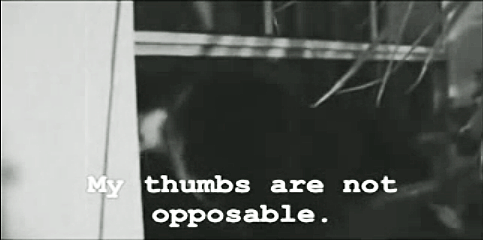
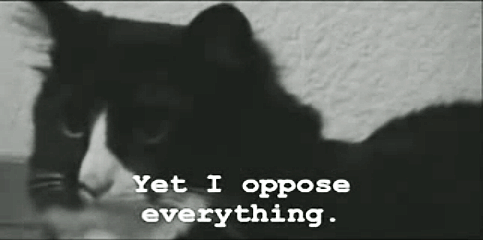
Figures 10 & 11: Bottomless Gaze
He is not human — he opposes the human, as he “oppose[s] everything” else. This brings us back to Henri as “singular.” Henri is set apart from both humans and from the human expectations of cats. He fits into neither category, which Braden claims was intentional. He is quoted as saying in one of many popular articles on the Henri phenomenon, “’Henri just couldn’t have contempt for humans…. He had to have it for cats, too, and that’s what made it work” (Morrissette). He has “contempt” for everything because, like the tortured individual he is, he does not see himself represented accurately in his surroundings. Instead, he is “scorned” equally by the human and the common representation of the nonhuman. Henri’s first video suggests that there is, or ought to be, another possibility.
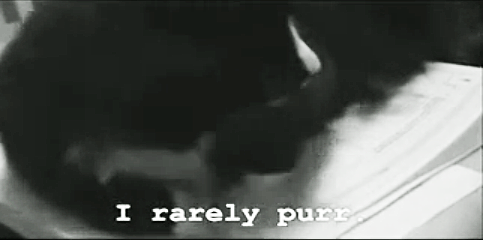
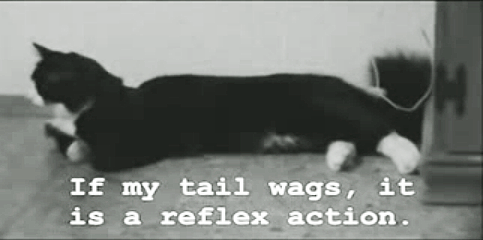
Figures 12 & 13: Absence of the Word
Henri often refuses to communicate on human terms or through human assumptions; he claims to “rarely purr” and calls his tail wagging “a reflex action” rather than an attempt to speak. This is Derrida’s “absence of the word.” This is the silent and unknown depth of the “bottomless gaze” of the animal. Henri manages to use a human voice to criticize human voices, while suggesting that he is beyond language himself, opposing common conceptions of the nonhuman experience. This suggestion would not be made available to us without moving first through anthropomorphism. Braden needed to show Henri “speaking” in order to suggest that there is more to the feline experience than the desire for language. While anthropomorphism is certainly not where investigation into the nonhuman world should end, it is perhaps a necessary step along the path. Jane Bennett, in her Vibrant Matter (2010), concurs. She writes, “maybe it is worth running the risks associated with anthropomorphizing (superstition, the divinization of nature, romanticism) because it, oddly enough, works against anthropocentrism: a chord is struck between person and thing, and I am no longer above or outside a nonhuman ‘environment’” (120). In this case, the animal gaze is the “thing” with which a chord is struck and we abandon the idea of the animal as beneath us. The next step is to acknowledge that it is separate from our conceptions of it entirely.
Henri’s public is drawn into his experiences through humor and empathy and thereby begins to work through his difficulties with language and representation in a hostile world. It is the combination of this urge to understand and the actor/role dynamic that begins to emerge as the next step beyond anthropomorphism. Henry, the real cat behind Henri, plays a role. This would mean that Henri’s thoughts and experiences are not Henry’s. The question then becomes, who (or what) is Henry? Almost a third of Netburn’s LA Times article focuses, not on the videos or on Braden, but on the lived experience of Henry the cat. “When the weather is nice, Henry spends most of his time outside, hiding under the trees and bushes around his owner’s grassy front yard. Henry’s owner describes the cat as a ‘gentle hunter.’ He’ll often bring birds and small mammals back to the house, but they are almost always alive” (Netburn). With the exception of the owner’s misrepresentation of Henry’s actions as “gentle,” these are definable actions of the animal as animal. He hides under trees and bushes; he hunts but brings the animal back alive. He does purr, and frequently. He doesn’t hide when company comes to the house. This urge to investigate the actions of a nonhuman other opens up the possibility for the non-anthropomorphized animal that could, perhaps, attempt to represent itself. While we look toward this possibility, there will always be the threat of misunderstanding and subjecting the animal to language all over again, countered by the equal threat of silencing it and removing its ability to critique. The path is precarious but clearly essential.
The first “Henri” film may or may not have been intended to open these particular doors, but it certainly indicates the ways in which the public’s perception of the nonhuman has been and continues to be structured. This question of the animal gaze will always come back to language, the power or “nonpower” of representation, and our discomfort at the potentially bottomless depth of its understanding and judgment. As Braden has continued to film Henry the cat and begun profiting on his enterprise, the object of these films has become the product he is benefiting from rather than the animal experience. Henri now uses references to internet memes to garner his laughs and thinks about his fame as much as he thinks about the judgments of his owners. His critiquing gaze rarely delves deeper than surface mockery. This is the unfortunate result of the hyper-individualization of celebrity and the actor/role relationship in this instance. Braden profits off of these films rather than Henry and it is Braden who therefore decides what Henri will say. Braden, like Alice, can and does miss the mark on occasion. Yet the first film will stand as a testament to the interpretive possibilities of the burgeoning critical genre of cat videos.
Works Cited
Bennett, Jane. Vibrant Matter: A Political Ecology of Things. Durham: Duke UP, 2010.
Braden, Will. “Henri.” YouTube. YouTube, 24 May 2007. 28 Oct. 2012.
Derrida, Jacques. The Animal That Therefore I Am. Ed. Marie-Louis Mallet. Trans. David Wills. New York: Fordham UP, 2008.
Manarino, Matthew. “’I’m told I’m Famous on the Internet’: An Interview with Henri Le Chat Noir.” Newmediarockstars.com. New Media Rockstars. 12 Nov. 2012. Accessed: 1 Mar. 2015.
Morrissette, Mellissa. “Henri the Cat Goes Viral, Turns Profit in the Name of Art.”Abcnews.go.com. ABC News. 27 Oct. 2012. Accessed: 1 Mar. 2015.
Netburn, Deborah. "Henri, Afflicted By Fame." LATimes.com. Los Angeles Times. 24 Oct. 2012. Accessed: 1 Mar. 2015.